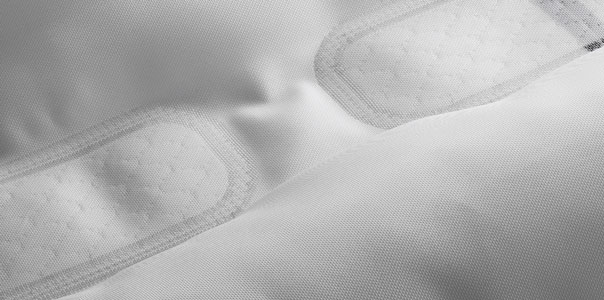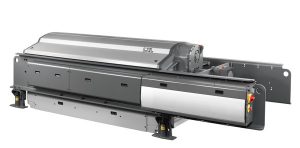Stäubli offers cutting-edge machinery for the most sophisticated technical textiles
TW Special Report
Technological development in the production of textile surfaces has enabled the manufacture of a growing number of automobile components based on technical textiles. These components include body parts as well as interior trim parts such as floor mats, seat covers, ceiling panels and dashboards. In aircraft construction, it is now standard practice that fuselages — or nearly entire aircraft bodies — are built with the aid of industrial textiles. Highly versatile fabrics for such applications have been created through the application of significant know-how by weavers and their machinery suppliers — both of whom invest heavily in technical advancements.
Research and development continues to be intensified in the textile manufacturing industry throughout the entire production chain and supported by manufacturers and specific training programs offered by textile universities. Today, the list of potential applications for textile products can be almost infinitely extended.
Regarding composite materials, a significant step toward serial production was shown by multiple exhibitors at this year’s JEC trade shows in Europe and the United States. But in terms of more complex composites such as 3-D multilayer weaves and spacer fabrics, product engineers in all industries — including automotive, building construction, leisure, nautical and aeronautic — are striving to identify precise areas of application in order to merge the advanced weaving possibilities with their needs in terms of technical requirements and woven components. Thus, product designers must understand the possibilities and special advantages offered by latest weaving machines, such as those in the product range of Switzerland-based Stäubli International AG. These machines offer a wide range of capabilities, such as freedom in design and format, fail-safe operation, drapability, precise definition of the elasticity of the fabric, weaves with reinforcement in certain areas over the weaving width, supporting the integration of the fabric in any component, and precise and gentle yarn treatment — the basis for perfect quality in the final product. Furthermore, advanced weaving technologies can shorten workflows, making for more economical production of the fabric and the final product.

3-D Textiles In A Wide Range Of Formats
In recent years, a new type of technical multilayer fabric — so-called 3D textiles — has appeared on the market. Finished products incorporating these textiles are used in applications with increasingly stringent mechanical requirements. One specific example is the aerospace industry, where traceability and reproducibility are central aspects of product specifications. Critical in the production of such industrial textiles is the ability to precisely control the arrangement of the warp threads within the shed of the various layers. This precise control is perfectly supported by Stäubli’s UNIVAL 100 — a unique servo-driven single-end control jacquard machine. The warp-thread control supported by servo-driven individual actuators, allows the production of a great variety of technical textiles and 3-D multilayer fabrics. Depending on the configuration desired, the unit can be fitted with anywhere from 512 to 15,360 actuators in various designs.

Modern Airbag Manufacturing Methods
The latest jacquard weaving technology has made it possible to manufacture complex airbag structures with woven seams. These one-piece woven (OPW) airbags give designers great flexibility in creating patterns and designs. They also reduce the number of production steps, thereby reducing production time. Side-curtain airbags, activated by a lateral collision, are shaped according to the interior contour of the particular car they are fitted in. Their shape and structure are created at the weaving stage. As a result, no subsequent sewing operation is required. To effectively protect passengers in a rollover, OPW side-curtain airbags must remain inflated for several seconds. This is best accomplished by using a sealed cushion with woven seams. OPW airbags are woven on modern high-speed jacquard weaving machines. The warp material, the variety of fabric patterns, and the importance of precisely shaped airbags require the use of a robust and reliable jacquard machine. For maximum flexibility in the creation and design of airbags, weavers require a high number of hooks, which makes control of each individual warp end possible. The extra-reinforced drive elements and the rigid structure of Stäubli’s LXL jacquard machine — available in formats from 6,144 hooks to 18,432 hooks — are ideal for weaving very high-load fabrics such as airbags. The machine’s lifting mechanism ensures accurate shed geometry and vibration-free operation even at high speeds.
At the heart of the LXL are MX modules, serving as the link between the lifting mechanism and the harness. For each weft insertion, each hook of the modules can be positioned either up or down, corresponding to the individual pattern required for each type of airbag and adapting to the complexity of the design. Each hook is driven independently, thanks to the operator-friendly JC7 controller in which all weaving data are stored and then transmitted to the jacquard modules, pick by pick. All data can easily be transferred to and from the jacquard controller via USB stick or network.
Delicate Automated Weaving Preparation
Filtration fabrics are among the technical textiles upon which users place the highest demands. Filter fabrics are used in process filtration, silk screening, as filter components, in medical applications and also in architecture. Ultrafine fabrics increasingly are used in the high-tech field of smart textiles.
One thing is common to all these application areas: Precision fabrics are required — and this calls for customer-specific solutions. Highly specialized weaving mills possess the necessary know-how. These mills are not just weavers, but can respond to the individual needs of the application technology and can ensure on-time delivery of a specified end product made using the finest yarns.
But before the yarn can be woven, the warp must be drawn into the weaving harness. Warps can measure up to 400 centimeters in width, comprising tens of thousands of threads — sometimes in numbers approaching 100,000 threads.
To streamline the drawing-in process, Stäubli offers automatic drawing-in machines that can handle up to 200 ends per minute. Here, the extreme yarn count of sometimes less than 7 denier, or 32 microns, places extremely high demands on the drop wires, heddle, reed, and every other element that comes into contact with the threads.
State-of-the-art image processing makes it possible to flawlessly separate individual threads from a dense sheet of warp threads featuring up to 200 threads per centimeter. Programmable repeat control ensures correct reed dent and drawing in to harness frames, thereby ensuring the specified fabric properties. Stäubli’s automatic drawing-in machines not only handle the finest threads very carefully, but also can handle different types of threads in the same warp layer. Even abrasive yarns such as Kevlar® or fiberglass can be processed, thanks to specially coated thread-handling elements. The SAFIR S80 can even work from two stacked warp beams — up to four different thread layers and materials including S- and Z-twisted yarns.
As the technical and quality requirements for technical textiles and composites grow, machinery manufacturers will continue to support the industry with ever-increasingly sophisticated machinery and technologies.
September/October 2016




